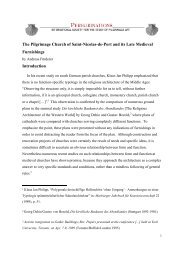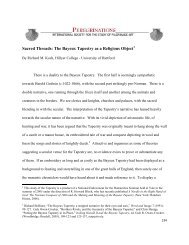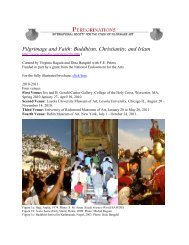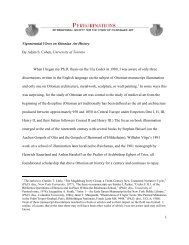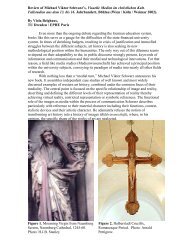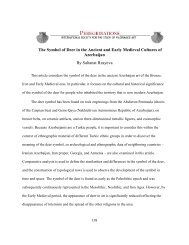The Bayeux Tapestry and the Vikings - Peregrinations
The Bayeux Tapestry and the Vikings - Peregrinations
The Bayeux Tapestry and the Vikings - Peregrinations
You also want an ePaper? Increase the reach of your titles
YUMPU automatically turns print PDFs into web optimized ePapers that Google loves.
she puts it, <strong>the</strong> argument seems a bit far-fetched, but <strong>the</strong>re will undoubtedly be more said<br />
about it. O<strong>the</strong>r researchers have drawn attention to <strong>the</strong> Sc<strong>and</strong>inavian character of <strong>the</strong><br />
framing doorway.<br />
Tribute must be given to <strong>the</strong> research of <strong>the</strong> late Lucien Musset, professor of<br />
history at <strong>the</strong> University of Caen. His publications are consulted in all <strong>the</strong> studies of<br />
Nordic elements in <strong>the</strong> <strong>Bayeux</strong> <strong>Tapestry</strong>. Recognizing <strong>the</strong> Sc<strong>and</strong>inavian elements in <strong>the</strong><br />
different cultures of north-west Europe during <strong>the</strong> Middle Ages, Musset was <strong>the</strong> pre-<br />
eminent transmitter of <strong>the</strong> influence of this heritage on our underst<strong>and</strong>ing of <strong>the</strong> <strong>Tapestry</strong>.<br />
During <strong>the</strong> twentieth century, <strong>the</strong> Sc<strong>and</strong>inavians, <strong>the</strong> <strong>Vikings</strong>, <strong>and</strong> <strong>the</strong> <strong>Bayeux</strong><br />
<strong>Tapestry</strong> became intricately linked once more. It is possible to see <strong>the</strong> Sc<strong>and</strong>inavians,<br />
<strong>and</strong> perhaps <strong>the</strong> <strong>Vikings</strong>, as <strong>the</strong> common link between opposing camps, as <strong>the</strong> common<br />
element in both Engl<strong>and</strong> <strong>and</strong> Norm<strong>and</strong>y. Ra<strong>the</strong>r than interpreting <strong>the</strong> <strong>Bayeux</strong> <strong>Tapestry</strong> as<br />
an Anglo-Norman document, we should see it as a reflection of <strong>the</strong> more nuanced society<br />
<strong>the</strong> Conquest produced, one that combined English, Anglo-Danish, <strong>and</strong> Norman cultures.<br />
In <strong>the</strong> preface to his book, <strong>The</strong> <strong>Bayeux</strong> <strong>Tapestry</strong> <strong>and</strong> <strong>the</strong> Battle of Hastings, Mogens Rud<br />
explains that his interest in <strong>the</strong> subject has been spurred by one fact: “I am a Dane <strong>and</strong> as<br />
such a kinsman of both <strong>the</strong> Anglo-Saxons <strong>and</strong> <strong>the</strong> Normans.” 36 That statement says it all.<br />
36 Mogens Rud, <strong>The</strong> <strong>Bayeux</strong> <strong>Tapestry</strong> <strong>and</strong> <strong>the</strong> Battle of Hastings 1066, trans. Chris Bojesen, (1983;<br />
Copenhagen: Eilers, 2001), 8.<br />
48



